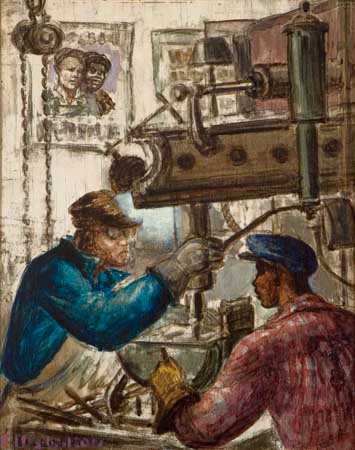Sale 2156 - Lot 20
Unsold
Estimate: $ 40,000 - $ 60,000
ELLIS WILSON (1899 - 1977)
Machine Shop.
Oil on panel, circa 1941-44. 495x385 mm; 19 1/2x15 1/4 inches. Signed in oil, lower left.
Provenance: Neal Auction Company, New Orleans, LA, sold Feb. 2, 2002; Robert Henry Adams Fine Art, Inc., Chicago, IL; private collection, Chicago, IL.
Exhibited: hung behind Senator Barack Obama's desk in his private Senate office from April 2005 until April 2008. African-American Art by Modern Masters, Robert Henry Adams Fine Art, Inc., Chicago, September 2005; illustrated in color in the exhibition catalogue.
After becoming the United States Senator from Illinois in 2004, Barack Obama asked select art galleries if he could borrow important historic paintings by artists who had connections to Illinois. Ellis Wilson's Machine Shop was a favorite of the junior Senator, and he hung the work over his desk in his private office for the past three years. Clearly, Wilson's early painting of his fellow African-American workers in a defense plant resonated with Obama on a political and personal level. Created during a period of war in the Democratic Roosevelt era, the piece celebrates African-American workers and their patriotic contributions to the war effort. Personally, Senator Obama's choice to feature a work by an artist who attended the Art Institute of Chicago because he was not allowed to attend art schools in his native Kentucky, speaks to Obama's pride in, and connection to, his own ethnic and cultural history. On the factory wall above the two drill press operators is a poster showing a black worker and white worker, shoulder to shoulder. The message projected, one of unity, has become a central theme in Barack Obama's campaign to become the next President of the United States.
Ellis Wilson was born in Kentucky, trained at the Art Institute of Chicago in the 1920s, and moved to New York in 1928 where he was a regular exhibitor in important early exhibitions of work by African-American artists. Between 1941 and 1944, Wilson worked in an aircraft factory. His fellow workers became the subject of several paintings that he submitted with his application for a Guggenheim Fellowship, which he won in 1944. Using the financial resources of his fellowship, Wilson traveled throughout the South painting Black workers. After exhibiting in several museum exhibitions in the 1940s, Wilson traveled to Haiti in 1952 on the first of several visits that resulted in a large body of work in his later, more abstract style.
Machine Shop.
Oil on panel, circa 1941-44. 495x385 mm; 19 1/2x15 1/4 inches. Signed in oil, lower left.
Provenance: Neal Auction Company, New Orleans, LA, sold Feb. 2, 2002; Robert Henry Adams Fine Art, Inc., Chicago, IL; private collection, Chicago, IL.
Exhibited: hung behind Senator Barack Obama's desk in his private Senate office from April 2005 until April 2008. African-American Art by Modern Masters, Robert Henry Adams Fine Art, Inc., Chicago, September 2005; illustrated in color in the exhibition catalogue.
After becoming the United States Senator from Illinois in 2004, Barack Obama asked select art galleries if he could borrow important historic paintings by artists who had connections to Illinois. Ellis Wilson's Machine Shop was a favorite of the junior Senator, and he hung the work over his desk in his private office for the past three years. Clearly, Wilson's early painting of his fellow African-American workers in a defense plant resonated with Obama on a political and personal level. Created during a period of war in the Democratic Roosevelt era, the piece celebrates African-American workers and their patriotic contributions to the war effort. Personally, Senator Obama's choice to feature a work by an artist who attended the Art Institute of Chicago because he was not allowed to attend art schools in his native Kentucky, speaks to Obama's pride in, and connection to, his own ethnic and cultural history. On the factory wall above the two drill press operators is a poster showing a black worker and white worker, shoulder to shoulder. The message projected, one of unity, has become a central theme in Barack Obama's campaign to become the next President of the United States.
Ellis Wilson was born in Kentucky, trained at the Art Institute of Chicago in the 1920s, and moved to New York in 1928 where he was a regular exhibitor in important early exhibitions of work by African-American artists. Between 1941 and 1944, Wilson worked in an aircraft factory. His fellow workers became the subject of several paintings that he submitted with his application for a Guggenheim Fellowship, which he won in 1944. Using the financial resources of his fellowship, Wilson traveled throughout the South painting Black workers. After exhibiting in several museum exhibitions in the 1940s, Wilson traveled to Haiti in 1952 on the first of several visits that resulted in a large body of work in his later, more abstract style.

Exhibition Hours
Exhibition Hours
Aliquam vulputate ornare congue. Vestibulum maximus, libero in placerat faucibus, risus nisl molestie massa, ut maximus metus lectus vel lorem.


